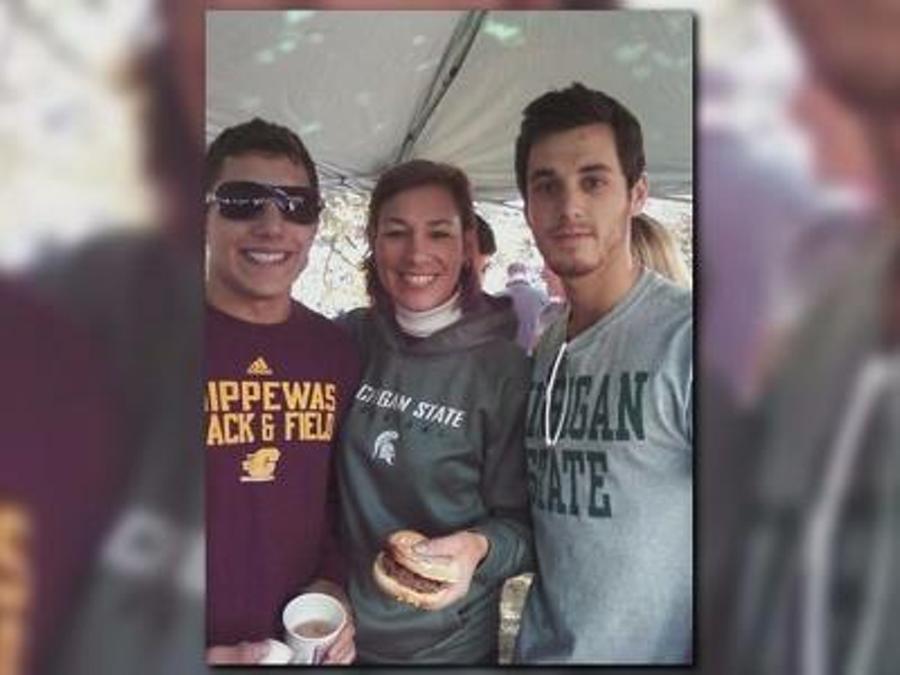Michigan Students Will Learn To Save Lives With CPR Training

Brett Kuhn, Cindy Kuhn and Chris Slack tailgate during a football game in 2011. Slack performed life-saving CPR on Brett Kuhn a year earlier.
Cindy Kuhn's son is alive because his best friend learned how to perform CPR during health classes at Novi High School.
Now all Michigan students will receive instruction in cardiopulmonary resuscitation — thanks to legislation approved in December.
"You just never know when you're going to need it," said Kuhn, a fifth-grade teacher at Novi Meadows Upper Elementary.
About 357,000 Americans each year suffer cardiac arrest outside of a hospital, and only about 8% of them survive, according to the American Heart Association.
In 2010, Kuhn' son, Brett, went into cardiac arrest while a freshman at Central Michigan University. He was 18, and received life-saving CPR from best friend Chris Slack, a freshman at Western Michigan University, who was visiting the CMU campus. Both graduated from Novi High, where freshmen learn CPR during health classes, Kuhn said.
Few Michigan schools require such training, but it will become the norm beginning in the 2017-18 school year. The new Michigan rules mandate that the health classes required for graduation be altered to include instruction in CPR and automated external defibrillators (AED).
"We have estimated it would add about 100,000 additional trained individuals every year. That's pretty significant," said Sarah Poole, government relations director for the American Heart Association.
The association has worked to get similar rules on the books in states across the U.S. Michigan would become the 36th state to require such instruction. In Michigan, students will be required to only learn hands-only training, meaning they would learn to do chest compressions but wouldn't be required to learn things such as mouth-to-mouth resuscitation. They would only need to receive the 30-minute instruction once between the 7th and 12th grades.
The legislation was sponsored by Sen. Tonya Schuitmaker, R-Lawton, and originally cleared the Senate in May by a 37-0 vote. On Dec. 14, it passed the House on a 98-8 vote; the Senate later that day approved it again to OK minor changes made in the House. Rep. Thomas Hooker, R-Byron Center, introduced the House version of the bill.
In 2004, the state began requiring new teachers to take a course in first aid and CPR.
"We’ve simplified CPR to the point that we know that folks who react quickly and even just do the chest compression can increase a person’s survival rate," Poole said.
The instruction, she said, can be completed in as little as 30 minutes and doesn't require being taught by a certified CPR/AED instructor. But teachers would still have to undergo some training in order to teach the lessons.
Chippewa Valley Schools is in its second year of offering CPR instruction to students. Staff also have been trained.
"We like it because our students can gain acceptable levels of CPR skills in about 30 minutes," said Diane Blain, spokeswoman for the district. "We're committed to it because we feel it's really important to train this next generation of people to help save lives."
It's already made a difference. On May 12 at Seneca Middle School, a guest teacher from Macomb Community College passed out in a science lab. Staff members performed CPR and used an AED unit to revive him.
"The Seneca team was credited for saving this man's life," Blain said.
Meanwhile, nearly two years ago in Fowler, a student who had just learned CPR a few weeks before performed it on his 3-year-old brother, saving the toddler's life, Poole said.
The association has committed to investing $120,000 to provide some resources and equipment for schools to use. It also will help connect schools to volunteers across the state who can provide training and answer questions.
The legislation encourages schools to use "locally available resources to provide the instruction," including emergency medical technicians, paramedics, police officers, firefighters, trained teachers or other school employees and representatives of the American Red Cross or the heart association.
Kuhn, who has CPR certification, tells her fifth-grade students about her son's experience every year.
"They're never too young to learn CPR, especially if they're taking care of younger siblings," she said.
Brett Kuhn, now 24, went into cardiac arrest on a Friday evening when his family, Slack and Slack's parents were visiting the campus for the annual football game between CMU and Western Michigan University. After tailgating together, Brett and Slack went off to watch the game with friends, while the parents watched at a different location.
Sometime after the game ended, Brett went into cardiac arrest, falling forward, hitting a table and landing facedown on the floor. His friends thought he was goofing around, but when they turned him over and saw his face turning blue, they knew something was wrong. They sprang into action, with Slack not only performing chest compressions but also the rescue breathing.
"The first responders actually told Chris that he had no pulse, to stop CPR," Cindy Kuhn said. But Slack, who had been best friends with Brett since elementary school, wouldn't stop.
"It's because of the gumption of this boy that he would not give up," Cindy Kuhn said.
Detroit Free Press
Story Credit: http://www.wzzm13.com/news/local/michigan/michigan-students-will-learn-to-save-lives-with-cpr-training/381219568


